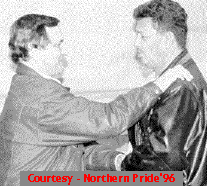Please keep in mind that the article was written originally in 1996.
North Western Saskatchewan is a vast region that is
inhabited mostly by Metis, and First Nations who speak the Dene (Chipweyan),
Cree and Michif languages as First languages. English is a second language,
while French used be the spoken language as early as the 1950's when the Church
operated the schools.
Today, however, like in many other communities the Aboriginal language has eroded
to the point many of our younger generations have lost the ability to speak
their mother tongue. Much of it is directly related to modern development, such
as television, communications that are only spoken in English. In many homes
no Aboriginal language is spoken at all and that has caused the languages to
be lost.
Socio-Economic Development has always been a big issue for North West Leaders.
Today, employment opportunities are mainly in the Uranium mining industry with
a few people employed in gold mining north of La Ronge. Other resource sector
employment is in forestry, such loggers, sawmill operators, and other related
jobs. Trucking employs many Northerners that transport raw resource material
South, such as uranium oxide, logs, lumber etc.
Many Aboriginal peoples still depend upon the seasonal industries such as trapping,
commercial fishing, wild rice production. Other spin-off benefits related to
forestry are tree planting, pine cone picking, wild mushroom harvests and there
are a few that market wild berry products. Many Northern Women still produce
first class handicrafts through beading mocassins, mukluks, gauntlets, leather
jackets produced from moose, caribou, or deer hides plus, many have to resort
to using commercially tanned hides because genuine home smoked hides are becoming
increasingly rare as well as expensive to purchase. Besides, that is also another
art that is slowly dying off to commercial stuff.
Even though there are many opportunities, the number of jobs available at one
given time has resulted in many unemployed Northerners, so the welfare rate
and the unemployment rates are sky high. Many young people and older people
have a great difficulty in finding employment especially in todays' employment
market where technical training is a necessity. Government and Training Agencies
don't seem to be able to catch up with the employment training needs at any
one given time. There are also the related costs to train as well; so, that
has caused inhibiting factors on the training providers.
The Metis Nation of Saskatchewan has been involved in Tripartite Agreement with
the Federal and Provincial Governments as well as, getting involved with the
Northern Municipalities. As a matter of fact, on February 23, 1996 the NWSMA
Leadership and the Metis Nation of Saskatchewan signed a "Protocol Agreement"
that states that both the North West Municialities and the Metis Nation of Saskatchewan
North West Metis Locals will work closely together on all issues involving the
NWSMA communities and related socio-economic opportunities. The Metis Political
organizations and the NWSMA organizations must share their ideas, and get each
other involved in any dealing with the Federal and Provincial governments. Below
is photo of Jim Durocher, President of the Metis Nation of Saskatchewan and
Louis Morin, Chairman (as he then was) of the NWSMA having a hardy handshake
after signing the Protocol Agreement at Buffalo Narrows.

Jim Durocher in 1996 was President of the Metis Nation of Saskatchewan and Louis Morin was Mayor of Jans Bay and Chairman of the North West Saskatchewan Municipalities Association. Jim Durocher is now in 2001-2001 a consultant and Louis Morin is Assistant Manager of the Headwaters Project.
 Beauval
Beauval
 Buffalo Narrows
Buffalo Narrows  Cole Bay
Cole Bay  Green Lake
Green Lake  Ile-a-la-Crosse
Ile-a-la-Crosse  Jans Bay
Jans Bay  La Loche
La Loche  Pinehouse
Pinehouse
 Dore Lake
Dore Lake  Michel Village
Michel Village  Patuanak
Patuanak  St. George's Hill
St. George's Hill  Turnor Lake
Turnor Lake
 Bear Creek
Bear Creek  Black Point
Black Point  Descharme Lake
Descharme Lake  Garson Lake
Garson Lake  Sled Lake
Sled Lake
On March 1st, 1994 the Metis Nation of Saskatchewan
with personal representation of Metis Local Presidents, some members, the
Executive et al. filed a Land Claim at the Queen's Bench Court in Saskatoon,
Saskatchewan.
The area encompasses the whole North West Region from the Alberta Border to
the West; down to just North of Meadow Lake to the South; East past Pinehouse
to around the Smoothstone area and North to Black Lake and west running just
underneath Lake Athabaska. (See the attached map which is only showing the
approximate area.) One of the arguments to be presented to the Courts is that
Metis' have resided, used and occupied the area since prior to 1870. That
the majority of the plaintiffs are direct descendants of the Metis that occupied
the above mentioned region. That the Rupert's Land Transferr 1870 by the Hudson's
Bay Company to the Dominion of Canada applies to the Plaintiffs as Indians
within the meaning of the term as used in the said Order and Royal Proclamation
and is a recognition and affirmation of the Plaintiffs' Aboriginal rights
and title.